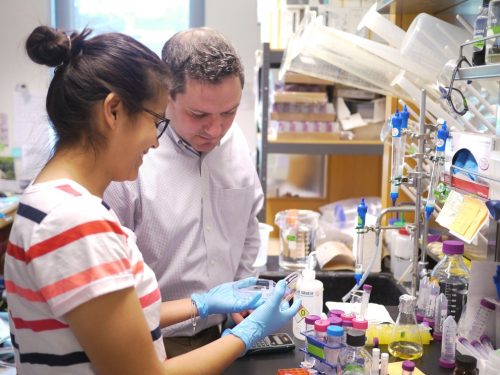Chemist uses giant spectrometer to speed drug development
A pro at navigating the labyrinthine hallways in the Chemistry Building, Scott Showalter, associate professor of chemistry, maneuvers from his office, class and a handful of laboratories throughout the day. But it’s one workspace in particular, home to the nuclear magnetic resonance (NMR) spectrometer, where Showalter is moving closer to the biomedical breakthrough he so desires.
He wants to help find a cure for cancer.
By harnessing the power of this mammoth drum-shaped hunk of machinery — essentially a gigantic MRI on stilts — Showalter is able to study the chemical structures of invisible-to-the-eye atoms stored in vials no larger than ballpoint pens.
The irony of the disproportion is not lost on him.
“We’re using this gigantic machine to fine-tune new methods for studying disordered proteins of microscopic proportions — of which 70 percent can be disease causing,” Showalter said.
Proteins are important to health because they regulate gene expression and execute cell functions, which can, for example, play a role in determining whether or not a pancreas creates enough insulin or a cellular mutation becomes cancerous.
“These disordered proteins are too small to study under a microscope, but the behavior of the infinitesimal magnets in the atoms that comprise the proteins is the key to our work,” Showalter explained. “So, we’re putting the atoms in the presence of the biggest magnet we can find to get them dancing: a NMR spectrometer.”
The spectrometer uses an ultrastrong magnet and radio frequency circuitry similar to an FM radio to analyze the atoms’ structure in ways other tools can’t.
Used by Penn State scientists for all kinds of research, the spectrometer packs a punch so strong — emitting a magnetic field nearly half a million times stronger than that of the earth below State College — that any smartphone, laptop or pacemaker that comes within its vicinity is fried.
It’s precisely this power that makes Showalter’s research possible.
By developing original methods for understanding these intrinsically disordered proteins (a relatively new field of biochemistry), Showalter and his team can provide researchers around the world with the knowledge and resources they need to design drug targets for treating such maladies as cancer, diabetes and hepatitis C.
“Unlike the other two-thirds of the proteins in our bodies, these disordered proteins are constantly changing form. At this point, scientists don’t understand them well enough to efficiently design drug molecules that can interact with them,” said Showalter. “Our primary goal is to understand them better on a fundamental level because the process of finding a drug is either going to be a very expensive, unguided fishing expedition or a well-informed, strategic collaboration.”
As one of the preliminary steps in this process, Showalter and his team are not only writing the code for and running the new experiments; they also are sharing their potentially life-saving findings with the world.
“Developing the code to conduct experiments on the NMR spectrometer is not easy. There are many, many scientists who are capable of using these instruments but who don’t consider themselves to be code developers,” Showalter said. “We’re broadly disseminating data files other people can upload to their NMR spectrometers so they can do the experiments, too.”
As part of his data management plan for publicly disseminating his research findings (a mandate of his National Science Foundation grant), Showalter shares the results of his original experiments in research journals and also uploads the code for the experiments into ScholarSphere, Penn State’s digital repository for curating and preserving research and scholarly data.
By openly sharing the original experiments with scientists around the world using the repository service, Showalter and his team are widening the net of researchers who can use the same NMR techniques to conduct their own biomedical research.
So far, it’s working.
After reading a paper written by Showalter and team in the “Journal of Physical Chemistry Letters,” which linked to the experiment’s code in ScholarSphere, a scientist at the Scripps Research Institute in Florida downloaded the data set and reached out to Showalter with some follow-up questions.
It’s having this kind of broad impact that gets Showalter out of bed in the morning.
“Our field is growing really quickly, and it’s been a lot of fun to be part of a new area of biochemistry and to be able to make major contributions with a technique that I care about. It has been pretty inspiring,” Showalter said. “I’m not a medical doctor, so anything that we might be able to do that can influence biomedicine and build bridges to the doctors and nurses who have a direct effect on a patient’s health is my goal. I can’t get there on my own, but hopefully together, we can help make innovations happen faster.”

